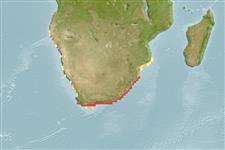Environment: milieu / climate zone / depth range / distribution range
Ökologie
seewasser demersal; tiefenbereich 1 - 30 m (Ref. 83528). Subtropical; 25°S - 36°S, 22°E - 35°E (Ref. 56293)
Southeast Atlantic: Namibia to East London, South Africa.
Size / Gewicht / Alter
Maturity: Lm ? range ? - ? cm
Max length : 35.0 cm TL Männchen/unbestimmt; (Ref. 4319)
Rückenflossenstacheln (insgesamt): 11 - 13; Rückenflossenweichstrahlen (insgesamt): 15-17; Afterflossenstacheln 3; Afterflossenweichstrahlen: 7 - 8. Head and body with small orange spots and few scattered dark brown blotches; caudal and anal fins dark grey, pelvic fins dusky yellow (Ref. 4319). Lower GR with 4-6 rudiments.
Occurs frequently among rocks in depths of 1 to at least 20 m (Ref. 4319). Commonly caught by anglers (Ref. 4319). Flesh excellent (Ref. 4319).
Life cycle and mating behavior
Geschlechtsreife | Fortpflanzung | Ablaichen | Eier | Fecundity | Larven
Heemstra, P.C. and J.E. Randall, 1986. Serranidae. p. 509-537. In M.M. Smith and P.C. Heemstra (eds.) Smiths' sea fishes. Springer-Verlag, Berlin. (Ref. 4319)
IUCN Rote Liste Status (Ref. 130435)
Bedrohung für Menschen
Harmless
Nutzung durch Menschen
Fischereien: kommerziell; Sportfisch: ja
Mehr Information
NamenSynonymeMetabolismusRäuberÖkotoxikologieFortpflanzungGeschlechtsreifeAblaichenSpawning aggregationFecundityEierEientwicklung
ReferenzenAquakulturAquakultur ProfilZuchtlinienGenetikElectrophoresesVererbbarkeitKrankheitenVerarbeitungNutrientsMass conversion
PartnerBilderStamps, Coins Misc.LauteCiguateraGeschwindigkeitSchwimmstilKiemenoberflächeOtolithsGehirngrößeSehfähigkeit
Tools
Zusatzinformationen
Download XML
Internet Quellen
Estimates based on models
Preferred temperature (Ref.
123201): 16.2 - 26.3, mean 22.1 °C (based on 119 cells).
Phylogenetic diversity index (Ref.
82804): PD
50 = 0.5005 [Uniqueness, from 0.5 = low to 2.0 = high].
Trophic level (Ref.
69278): 4.0 ±0.7 se; based on size and trophs of closest relatives
Widerstandsfähigkeit (Ref.
120179): mittel, Verdopplung der Population dauert 1,4 - 4,4 Jahre. (Preliminary K or Fecundity.).
Fishing Vulnerability (Ref.
59153): Low vulnerability (25 of 100).
Nutrients (Ref.
124155): Calcium = 89 [33, 186] mg/100g; Iron = 0.97 [0.51, 1.91] mg/100g; Protein = 17.5 [15.0, 20.5] %; Omega3 = 0.375 [0.226, 0.649] g/100g; Selenium = 18.6 [9.5, 40.5] μg/100g; VitaminA = 19.4 [5.9, 70.7] μg/100g; Zinc = 0.706 [0.492, 1.078] mg/100g (wet weight);
